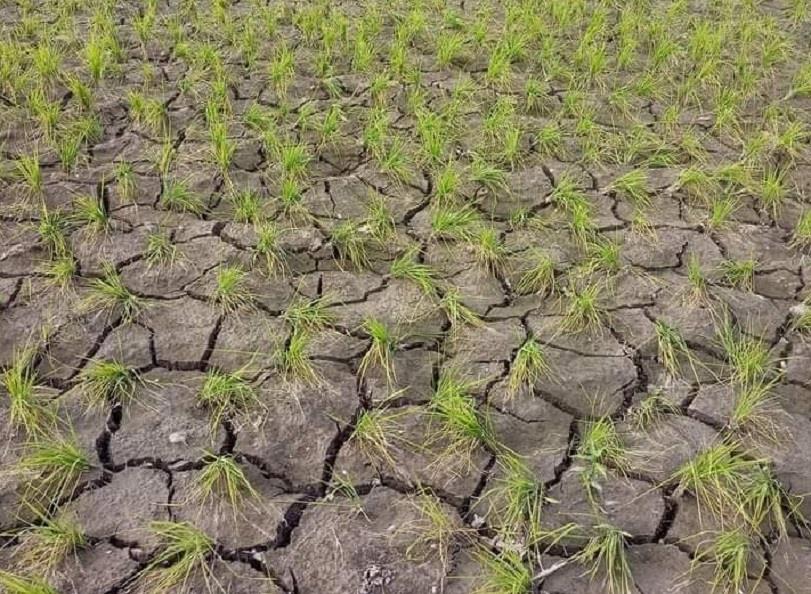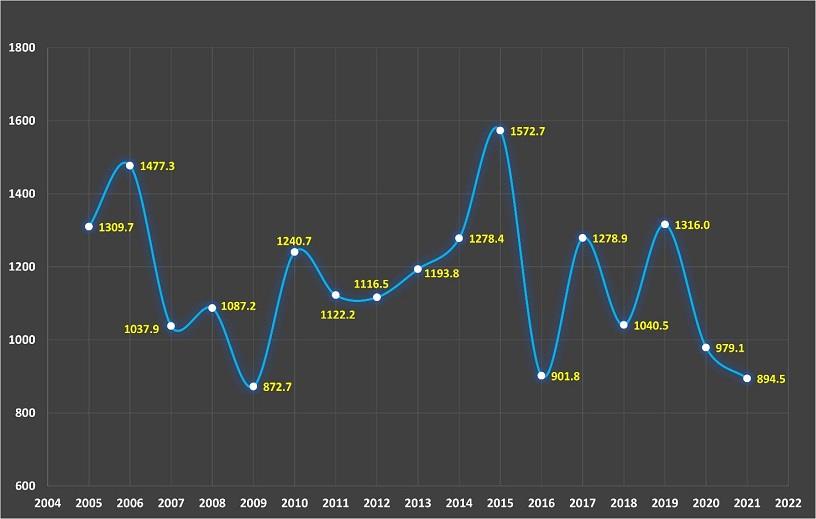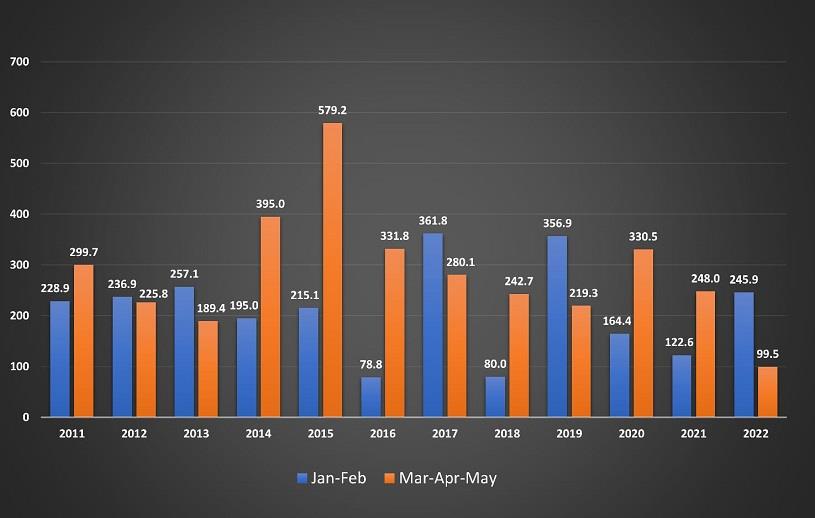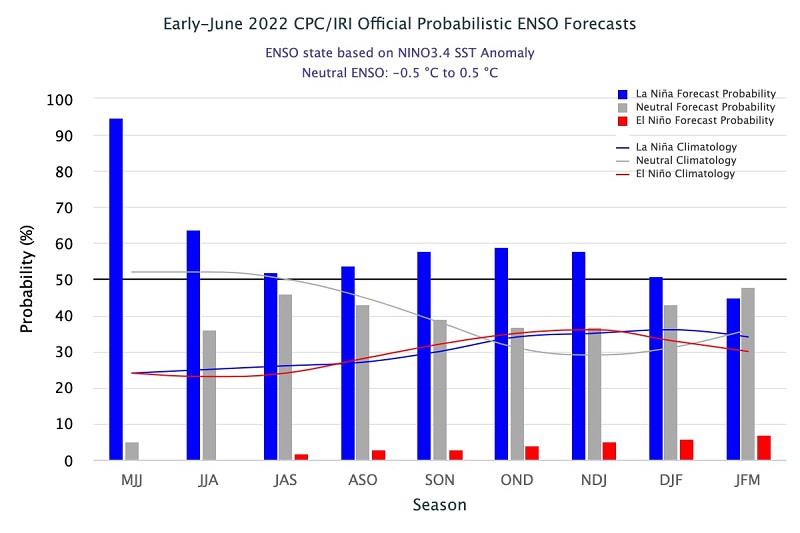(MENAFN- Kashmir Observer)

Representational Photo
By Faizan Arif Keng
JAMMU and Kashmir has been basking in the sun lately but it has not been warm for all. For those associated with the agriculture and horticulture sectors, the sun's sprint across spring and summer has been challenging. The weather that the Union Territory witnessed in March and April this year wasn't normal after all. Though it may have appeared pleasant, temperatures on several days were above-normal by 10 to 15 degrees Celsius. And of course, the 'Rainy March' was nowhere in sight. April and May too recorded below-normal rainfall. In fact, this trend has taken on from the years 2021 and 2020 which too witnessed rainfall much below the normal levels. Going by data points till now, it seems that this year is also going to continue its rift with the rains.
Background
In 2020, Jammu and Kashmir recorded 979.1mm of rainfall against an average rainfall of 1258.7mm. There was a deficit of 22%. In 2021, the deficiency reached 29% when the UT recorded just about 894.4mm of rainfall. It was the lowest rainfall since 2010.

The months from January to May are ones in which heavy snowfall is recorded in higher reaches which is essential for the formation of glaciers.
In the first five months of 2022, Jammu and Kashmir recorded a rain deficiency of 38%. Against a normal rainfall of 559.2mm, Jammu and Kashmir received only 345.4mm of rainfall between January 01 and May 31. In comparison, 34% deficiency was witnessed in 2020 and 11.5% in 2021 for the same time period. Between June and September 2020, 34% deficient rainfall was recorded in J&K and 29% in 2021.
In fact, from March to May 2022, the Union Territory received only 99.5mm of rainfall, which is the lowest Spring rainfall since 2005.
2020 was a La Niña year in which La Niña conditions developed in the latter part of the year. The La Niña conditions have continued since then with the recent MAM 2022 value at -1.1, indicating a moderate La Niña.
Present Scenario
In the first week of June, the water level of Jhelum at Sangam came down to 1 foot. It was a record-breaking, most reduced figure, for this time of the year. Usually, this figure would be a feature of the late Summers or the Autumn Season.
What explains this?
The deficient annual rainfall in 2020 and 2021, especially in the initial five months of the year, led to reduced cover of glaciers. The pattern proceeded this year when the UT received the highest deficient rainfall in recent 3 years. Not just this, an extreme heatwave impacted parts of Jammu and Kashmir in March and April.

Temperatures on several days remained above-normal in the range of 10 to 15 degrees Celsius. Srinagar recorded its warmest March in at least 131 years. Similar conditions were recorded in other parts of the erstwhile state. This resulted in the rapid melting of glaciers. Jhelum at Ram Munshi Bagh touched 9.86 feet on 17 March, which was just 6 feet below the 'flood alarm' level.
In April, Jhelum, nallahs and springs witnessed an extensive decrease in water levels. By May-end, some small Nallahs had dried up completely.
Drought is generally considered as a deficiency in precipitation over an extended period, resulting in a water shortage and causing adverse impacts on vegetation, animals or people. However, due to drought's varying characteristics and impacts across different regions, it is difficult to have a universally accepted definition of it.
Nonetheless, as per the 'Manual for Drought Management' published in 2016 by the Ministry of Agriculture, there are certain guidelines in place for a state government for declaring a drought.
In J&K, the rainfall deviation between March and May 2022 falls in the 'large deficient' category. The Standard Precipitation Index (SPI) is below minus 1.0 at most places in J&K. In south Kashmir, Pulwama district excluded, and Kupwara, the values of SPI are below minus 2.0, indicating extremely dry conditions.
This year, farmers in some areas were hesitant for paddy plantation as conditions had remained unfavourable for transplantation due to low water levels in water bodies.
The recent few spells of rainfall won't compensate for the loss we are facing for 2 years. Though, heavy rainfall recorded between 17 and 23 June may have saved us from drought this year.
However, it still remains crucial to see how much produce J&K will be able to generate this Kharif season as some of the farmers had earlier complained of losses while some had turned to sowing pulses and other cash crops.
The final assessment could be done later and accordingly, the government should then declare a drought on the off chance that the conditions are met. If not the whole UT, some areas may have faced an adverse impact on vegetation due to the earlier spell of dry weather.
Just like other streams, water level of Brengi Nallah was also low this year. Adding to the misery, multiple sinkholes appeared in the nallah in the latter half of February and the second week of June which led to the shortage of water in nearby areas. Locals of the area had even complained of drinking water scarcity.
Future Impact
The year 2020 and 2021 were associated with La Niña conditions in which below-normal rainfall was recorded in monsoon months. Kashmir region receives below-normal rainfall between June and September when La Niña conditions are prevailing.
The forecasters are predicting a 52% chance of La Niña and a 46% chance of ENSO-neutral during July-September 2022. This means that Kashmir region may receive below-normal rainfall this monsoon as well. This will then lower the water levels of Jhelum.

In 2021, September 08, Jhelum at Ram Munshi Bagh witnessed an all-time low water level at 1.89 feet.
Given the facts above, the conditions seem worse this year, water shortage may arise in some areas this pre-fall or Autumn season.
The forecasters are also indicating a 58-59% chance of La Niña during the fall and early winter before turning to neutral in mid-winter.
This may only result in below-normal or normal rainfall. Chances of excess rainfall for a whole season look minimum.
If the below-normal rainfall trend continues into the next year, this will make the conditions even worse. The upcoming winter may also receive slightly below-normal rainfall given that the models stick to the current forecast.
Views expressed in the article are the author's own and do not necessarily represent the editorial stance of Kashmir Observer
- The author is an independent Weather Forecaster better known as 'Kashmir Weather' across social media
Follow this link to join our WhatsApp group : Join Now
MENAFN01072022000215011059ID1104463796
Legal Disclaimer:
MENAFN provides the information “as is” without warranty of any kind. We do not accept any responsibility or liability for the accuracy, content, images, videos, licenses, completeness, legality, or reliability of the information contained in this article. If you have any complaints or copyright issues related to this article, kindly contact the provider above.